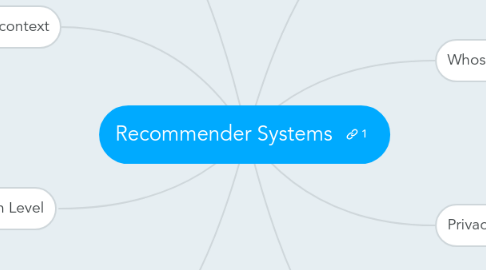
1. Purpose
1.1. recommendation itself
1.1.1. sales
1.1.2. information
1.2. education of user/customer
1.2.1. e.g. OWL tips
1.3. build community of users around products or content
1.3.1. e.g. TripAdvisor
2. Recommendation context
2.1. What is the User doing at the time of recommendation?
2.1.1. shopping
2.1.2. listening to music
2.1.3. hanging out with other people
2.2. How does the context constrain the recommender?
2.2.1. Groups
2.2.2. Automatic consumption (vs. suggestion)
2.2.3. Level of attention
2.2.3.1. Level of interruption
3. Personalization Level
3.1. Generic/Non-personalized
3.1.1. everyone receives same recommendations
3.2. Demographic
3.2.1. matches the target group
3.3. Ephemeral
3.3.1. matches current actitivity
3.4. Persistent
3.4.1. matches long-term interest
4. Interfaces
4.1. Types of output
4.1.1. predictions
4.1.2. recommendations
4.1.3. filtering
4.1.4. organic vs. explicit presentation
4.1.4.1. agent/discussion interface
4.2. Types of input
4.2.1. Explicit
4.2.2. Implicit
5. Domain
5.1. Content
5.1.1. News, information, text
5.1.2. Products, vendors, bundles
5.1.3. Matchmaking (other people)
5.1.4. Sequencies
5.1.4.1. e.g. music playlists
5.2. Novelty
5.2.1. new items
5.2.1.1. e.g. movies, books
5.2.2. re-recommend old ones
5.2.2.1. e.g. groceries, music
6. Whose Opinions
6.1. Experts
6.2. Ordinary "phoaks"
6.2.1. People Helping One Another Know Stuff
6.3. People like you
7. Privacy and Trustworthiness
7.1. Who knows what about me?
7.1.1. Personal information revealed
7.1.2. Identity
7.1.3. Deniability of preferences
7.2. Is the recommendation honest?
7.2.1. biases built-in by operator
7.2.1.1. "business rules"
7.2.2. vulnerability to external manipulation
7.2.3. transparency of "recommenders"
7.2.3.1. reputation
8. Recommendation Algorithms
8.1. Non-personalized summary statistics
8.2. Content-based filtering
8.2.1. Information filtering
8.2.1.1. Knowledge-based
8.3. Collaborative filtering
8.3.1. User-user
8.3.1.1. Item-item
8.3.1.1.1. Dimensionality reduction
8.4. Others
8.4.1. Critique / Interview-based recommendations
8.4.1.1. Hybrid Techniques

